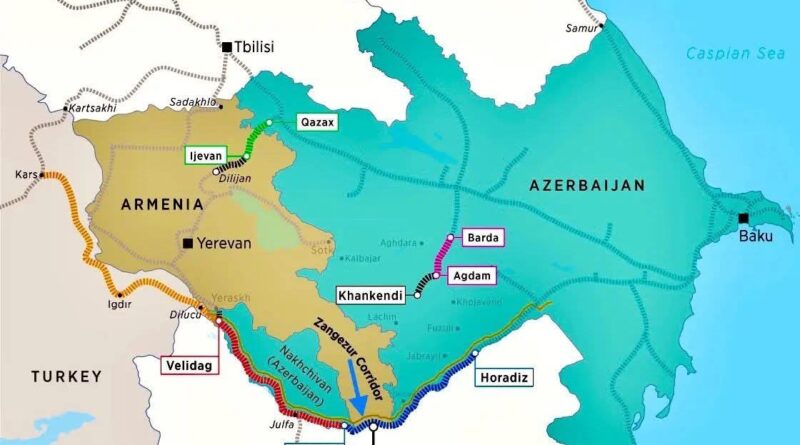The TRIPP Corridor: From the White House to Western Azerbaijan
Last meeting between U.S. President Donald Trump and Russian President Vladimir Putin in Alaska ended without results. No peace agreement or truce regarding the conflict in Ukraine was reached. However, the American leader is trying to ensure President Putin’s continued participation in negotiations on resolving the Ukrainian conflict. Experts claim that Trump has not yet played all his cards.For now, President Trump has made peace agreements a priority in his foreign policy. U.S. Secretary of State Marco Rubio stated that Trump “wants to be the President of Peace.” He added, “And so any time we see a conflict where we think we can make a difference, we get involved, and we've had good success in that regard. India-Pakistan, Thailand-Cambodia, the peace deal with Azerbaijan and Armenia, just a few days ago.” The latest document of note is the peace agreement signed on August 8 at the White House, ending the long-standing conflict between Azerbaijan and Armenia. During the ceremony, Azerbaijani President Ilham Aliyev and Armenian Prime Minister Nikol Pashinyan signed a seven-point trilateral declaration in the presence of President Trump.
The agreement, titled the “Agreement on Establishment of Peace and Inter-State Relations between the Republic of Azerbaijan and the Republic of Armenia,” has been initialed. The foreign ministers of both countries also jointly requested the dissolution of the OSCE Minsk Group. Key provisions include mutual respect for territorial integrity, a commitment to avoid violence, and measures to address uncontrolled borders. For the agreement to take effect, Armenia must amend its constitution and renounce claims against Azerbaijan. Only then will the peace agreement be officially recognized.
Key Provisions of the Azerbaijan–Armenia
Peace AgreementThis agreement is seen as a historic step toward lasting peace in the South Caucasus. Speaking at a White House press conference, President Trump noted, “ For more than 35 years, Armenia and Azerbaijan have fought a bitter conflict that resulted in tremendous suffering for both nations. They suffered gravely for so many years. Many tried to find a resolution, including the European Union. The Russians worked very hard on it, never happened. Sleepy Joe Biden tried, but you know what happened there. He tried for probably 12 minutes and didn’t work out. And many other countries tried and they were unsuccessful. But with this accord, we’ve finally succeeded in making peace, and we just left the Oval Office, where we signed voluminous documents and very important elements to the agreement.”A central provision of the agreement is that Azerbaijan will gain full access to its Nakhchivan region through a special transit corridor passing through Armenian territory. Previously, Azerbaijan’s access to Nakhchivan was limited due to the conflict, and residents could travel there only by air.Now, a secure overland route linking Nakhchivan with the rest of Azerbaijan through Armenian territory—the Zangezur corridor—has become a key priority. Officially, the corridor has been named TRIPP: the “Trump Route for International Peace and Prosperity”.
The TRIPP Corridor: Regional and European Significance
The corridor will benefit not only Azerbaijan and Armenia but also the economies of the entire region. It is a critical piece of infrastructure for fostering lasting peace and strengthening cooperation in the South Caucasus.With the corridor in place, the region will experience a more peaceful environment. Road and rail connections will be restored, border checkpoints reopened, and barriers to free trade removed.In a world where wars and national conflicts continue and Europe faces serious energy challenges, global transport corridors connecting continents are more important than ever. From this perspective, the Zangezur corridor, as part of China’s “Belt and Road” initiative’s Middle Corridor, is attracting growing international interest.The TRIPP corridor will complement the Belt and Road infrastructure. Its completion will open additional routes for the North–South transport corridor, increasing cargo flows from China through Azerbaijan. Goods can then travel via the Baku–Tbilisi–Kars railway through Georgia to Turkey and onward to Mediterranean ports via Zangezur.Note: During the Soviet era, the Zangezur corridor was part of Azerbaijan’s railway network. It has never belonged to Armenia’s railway infrastructure; it simply passes through Armenian territory, connecting the Nakhchivan Autonomous Republic with Azerbaijan and providing access to the Gulf via Iran.
Strategic Importance for Azerbaijan and the U.S.
President of Azerbaijan Ilham Aliyev emphasizes that opening this transport corridor is a key issue on the global political agenda. “Our main priority is to ensure unobstructed and safe passage from Azerbaijan to Azerbaijan,” he said. “This corridor connects one part of the country to another. Our cargo and citizens should not have to face Armenian border guards every time. This is a legitimate and just demand.”The corridor is vital not only for Azerbaijan but also for U.S. trade interests. It was also part of Armenia’s commitments signed on November 10, 2020, but no progress was made over five years. Azerbaijan has since built railways close to the Armenian border. Only 40 kilometers remain to complete the corridor.The project will include not just railway construction but also power transmission lines, fiber-optic cables, and energy infrastructure capable of carrying resources from Azerbaijan and neighboring regions. Armenia could become a transit country, while the U.S. will collaborate with third parties on the TRIPP project.Currently, the Washington agreement has not been ratified. Its provisions require Armenia to amend its constitution and renounce territorial claims against Azerbaijan. The Minsk Group must also be dissolved.
Russia and Iran’s Interests in the Zangezur Corridor
The U.S. and Turkey gaining influence over the corridor would reduce Russia’s presence in the South Caucasus. The corridor will operate under Armenian law, but the U.S. will manage sub-projects including roads, rails, pipelines, and optical fibers.
Through this project, the U.S. aims to expand its influence in the South Caucasus, weakening the roles of Russia and Iran. Iran, viewing the corridor as an “American imperialist” project, has reacted strongly, potentially creating obstacles. Moscow is gradually retreating from the region but remains influential, and the shifting balance may require Western support. The return of Western Azerbaijanis will play an important role in this geopolitical balance.
The Return of Western Azerbaijanis
Azerbaijan believes the corridor will accelerate the return of Western Azerbaijanis to their ancestral lands—currently within Armenia. This represents a symbolic return to Zangezur, lost by Azerbaijan in the early 20th century. Most of present-day Armenia, including its capital Yerevan (historically Iravan), historically belonged to Azerbaijan.President Aliyev states, “Western Azerbaijan is our historic land, confirmed by many historical documents and maps. Assigning Yerevan and Zangezur to Armenia was a historical injustice, a betrayal, and an unforgivable mistake.”The Azerbaijani government demands recognition of the right of forcibly displaced Azerbaijanis to return.
For the peace agreement to be fully implemented, Armenia must sincerely abandon its 200-year policy of hostility toward Azerbaijan and its territorial claims, amend its constitution, and ensure the return of Azerbaijanis expelled between 1987 and 1991.The principle behind the return is coexistence between Azerbaijanis and Armenians. This process is intended to strengthen, not strain, relations between the two nations.With the current geopolitical environment, the reopening of the Zangezur corridor raises hopes for international support for the return of Western Azerbaijanis.



